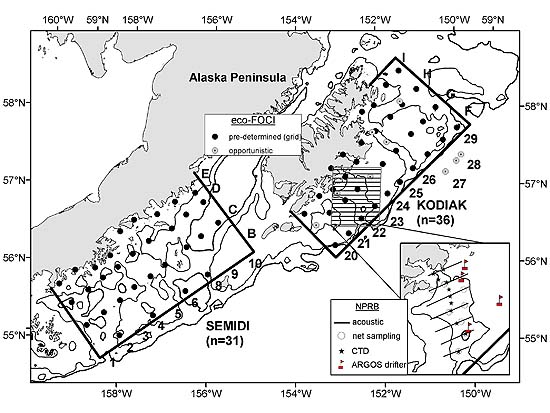Fisheries Oceanography Coordinated Investigations (FOCI)
The Ecosystems and Fisheries-Oceanography Coordinated Investigations Program (Eco-FOCI) recently completed a cruise on board
the NOAA ship Fairweather (July 2005). The Fairweather platform provided the unique opportunity to investigate
climate-biological interactions in the east Kodiak region of the GOA during the summer. The cruise was a joint effort of two NOAA
Line Offices (NMFS and the Office of Oceanic and Atmospheric Research) to examine how nutrients, phytoplankton, zooplankton, and
ichthyoplankton over the continental shelf are advected to nearshore juvenile fish nursery areas. Climate variability can affect
this transfer of production by modifying the paths of the Alaska Coastal Current and the Alaska Stream, potentially affecting the
fish that utilize the nearshore areas as nursery grounds in the late spring and summer.
Biological sampling included bongo and Tucker trawls to provide new information on the distribution of larval and juvenile fish
and zooplankton. Oceanographic observations included deployment of satellite-tracked drifters to study eddy formation and current
trajectories, and conductivity-temperature-depth (CTD) samples to provide much-needed summer collected information on phytoplankton
biomass and distribution, and on nutrients that feed the continental shelf trophic web. Oceanographic and biological observations from
this research cruise will be integrated to provide a clearer picture of how the GOA ecosystem may respond to climate forcing during summer.
In addition to this valuable climate-ecosystem research, we were also able to accomplish additional sampling for several other studies.
We conducted multiple CTD casts in Barnabus Trough that will be used to characterize a local oceanographic front which may keep
aggregations of fishes (pollock and capelin) separated. We were also able to occupy a series of stations that will compliment studies
conducted by ABL scientists on seafloor habitat, and we were able to collect samples of northern rock sole larvae which will be used
in ageing studies conducted at the AFSC Newport laboratory. Northern rock sole samples will be used to provide information on the
duration of time to settlement between the pelagic larval and benthic juvenile phases.
In all, the cruise was highly successful in meeting its objectives thanks in large part to the multimission capabilities of the
Fairweather and to her officers and crew. The vessel provided an excellent platform for work by the Eco-FOCI program, and
gave us an opportunity to obtain much-needed information on the functioning and dynamics of the GOA ecosystem during summer.
By Janet Duffy-Anderson
Recruitment Processes

Figure 3. Location of stations occupied during the fall Eco-FOCI cruise aboard the NOAA ship
Miller Freeman, 5-19 September. |
During 5-19 September, Eco-FOCI conducted a research cruise aboard the NOAA ship Miller Freeman. The primary cruise objective
was to collect data and samples for studying geographic variation in the productivity of forage fishes in two regions within the western
GOA (Fig. 3 above). The fishes targeted in this study were capelin, eulachon, and age-0 juvenile walleye pollock. These species are
abundant in midwater and eat zooplankton. They are also important prey for larger organisms such as fish, marine mammals, and seabirds.
Walleye pollock is a major component of the groundfish fishery in the GOA and Bering Sea.
Occupation of stations in the Semidi Island region extended a 3-year study that began in 2000 on the distribution of forage fishes and
their prey. Around the Semidi Islands, prey levels for forage fish in the Alaska Coastal Current (ACC) appear to be higher than outside
the current. In contrast, the Kodiak region is not greatly influenced by the ACC but appears to have high prey levels for forage fish.
Environmental data and samples of zooplankton and fish were collected at each of 67 predetermined grid locations. In each study region,
the targeted fishes comprised 67% of the catch by number, but only 5% by weight due primarily to the prevalence of large jellyfish.
Nine additional trawl tows were conducted opportunistically to identify echo-sign, or to collect potential forage fish predators.
A secondary cruise objective, supported by the North Pacific Research Board (NPRB), was to examine zooplankton abundance and composition
as a mechanism for geographic separation between capelin and sub-adult walleye pollock in the Barnabus sea valley (Fig. 3 inset).
ARGOS drifters and CTD casts were used to measure water flow (at 40 m) and identify water masses within the sea valley. Subsequent
acoustic transecting and net sampling was used to collect zooplankton and fishes from the different water masses. Capelin and age-0
juvenile walleye pollock comprised 30% and 60% of the catch by number.
By Matthew Wilson
>>>continued
 |

|
JAS2005 quarterly sidebar
AFSC Quarterly
Research Reports July-Sept 2005
Contents
Feature
ABL Reports
FMA Reports
NMML Reports
RACE Reports
REFM Reports
Items
Quarterly Index
Quarterly Home
|

